Top News
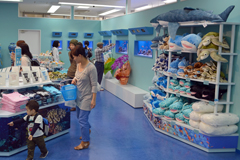
April 27, 2014 Ryukyu Shimpo
The Okinawa Churashima Foundation opened an Okinawa Churaumi Aquarium merchandise shop on Kokusai Street in Kumoji district of Naha on April 26. Many people visited the shop to buy products that were previously only sold at the aquarium and in the Yambaru areas of the northern part of Okinawa.
The shops displays a mini aquarium that contains clownfishes, a popular feature of the Okinawa Churaumi Aquarium. It also screens whale sharks swimming on a 200-inch TV, creating a unique and relaxing aquarium atmosphere.
The shop has a booth for special products from the Yambaru region.
Shop owner Keisuke Kato said, “By conveying the charms of Yambaru, mainly focusing on the aquarium, we would like to attract tourists to the northern areas of Okinawa.”
One of the visitors Yumi Takara said, “I bought a dried laver seaweed shaped like a whale shark. I am glad to have found this in Naha because I noticed and liked the product when I visited the aquarium before.”
(English translation by T&CT)
Go to Japanese
May 1, 2014 Ryukyu Shimpo
The estimated population of Okinawa as of April 1, 2014, has reached 1,414,148, according to statistics published on April 30 by the Okinawa Prefectural Government. The figures showed a decrease of 5,856 people from the previous month this year, but it marked a rise of 6,014 people in Okinawa compared with the same month the previous year. Okinawa’s population has increased by 21, 330 people in comparison with that of the Population Census 2010.
Compared with the same month the previous year, the northern area of the main island showed an increase of 0.08 percent to 127,693 people. The central area had an increase of 0.39 percent to 608,041 people. In the southern area, there was an increase of 1.23 percent to 254,906 people. Naha, the capital city, showed an increase of 0.25 percent to 319,680 people. Meanwhile, in the Miyako Islands the population decreased by 0.47 percent to 52,274 people. Yaeyama Islands had a decrease of 0.21 percent to 51,554 people.
Zamami Village showed an increase of 2.99 percent, which was the highest growth rate of all municipalities, followed by Taketomi Town with an increase of 2.28 percent. In some remote islands, the population decreased. Aguni Village showed a decrease of 4.51 percent, the prefecture’s biggest decrease, followed by Tarama Village with a decrease of 3.12 percent.
(English translation by T&CT)
Go to Japanese

April 25, 2014 Ryukyu Shimpo
From April 25 to May 7, the Ryukyu Kingdom’s Royal Crown with an ornamental hairpin is on display at the Naha City Museum of History. Tatsuro Furutsuka, a curator of the museum, hopes many people will visit the exhibition. He said, “This little crown contains many histories of the Ryukyu Kingdom.”
The Royal Crown was used for important ceremonies during the Ryukyu Kingdom era. It has 288 ornaments made of gold, silver, crystal, coral, and seven others. Two dragons that symbolize the Contact the Naha City Museum of History at 098 (869) 5266 for more detail.
(English translation by T&CT, Hitomi Shinzato)
Go to Japanese
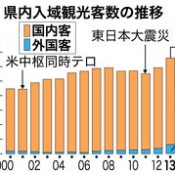
April 22, 2014 Ryukyu Shimpo
On April 21, the Okinawa Prefectural Government announced the number of tourists who visited Okinawa from April 2013 to March 2014 was 6,580,300, a new annual record. This represents an 11.1 percent increase from the previous year. It exceeded the previous record of 5,934,300 set in fiscal year 2008 by more than about 650,000. The total number of domestic tourists visiting Okinawa increased by 7.4 percent to 5,953,100. The total number of international tourists increased by 64.0 percent to 627,200. Both numbers hit new records high.
The increase in domestic trips by Japanese people and the rising travel demands from foreign customers because of the cheap yen boosted the number of tourists coming to Okinawa. The opening of a new airport in Ishigaki and the launching and extending of domestic and international routes by low-cost carriers also contributed to the growth. The Okinawa Prefectural Government had set a target of 6,300,000 tourist arrivals for the 2013 fiscal year, and has successfully achieved this goal.
Many airlines have launched direct flights between the main islands of Japan and Ishigaki Island after the new airport opened. On top of this, the opening of routes by low-cost carriers increased the total number of domestic tourists who visited Okinawa.
The number of tourists visiting Okinawa from Tokyo increased by 7 percent to 2,969,000. Those visiting from Kansai increased by 15.3 percent to 1,182,000, while 713,800 tourists came from Fukuoka, a 2.4 percent increase. The number of tourists from Nagoya increased by 5.6 percent to 479,300.
There were three new international routes: Taipei-Naha, Busan-Naha and Shanghai-Naha. The number of weekly flights at Naha Airport in 2013 was 70, a 42.9 percent increase from the previous year. The number of tourists from Taiwan increased by 70.1 percent to 254,100 and they formed the largest group of overseas tourists. Korean tourist numbers more than doubled to 98,400, and 92,400 tourists came from Hong Kong, an increase of 64.4 percent. Tourists from mainland China increased by 16.6 percent to 68,700.
(English translation by T&CT and Lima Tokumori)
Go to Japanese
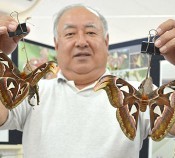
April 23, 2014 Ryukyu Shimpo
Thriving on Yonaguni island, the world’s largest Atlas moths have reached the time of emergence. They are called Ayamihabiru on Yonaguni Island. The Ayamihabiru Museum in Yonaguni displays a female moth that emerged on April 15, and a male that emerged on April 18. Visitors are surprised to see the large moths, which they often mistake for birds.
Atlas moths are designated as natural monuments by the Okinawa Prefectural Government. The Atlas moth has a wingspan of over 25 centimeters. Their adult lives are short. Male moths will survive only four days, and females will live for as long as nine days. They are nocturnal. Males fall apart overnight because they fly around, craving females.
Kotaro Matsumoto, a specialist at the Ayamihabiru Museum, said that the emergence of the moths started from the end of March, and it would continue until the end of April. The moth mating season takes place four times, from June to July, from August to September, and October to November.
“Atlas moths are well-known for their large body, but also they have a good-looking pattern. The white part of the feather is transparent and really beautiful,” said Matsumoto.
(English translation by T&CT)
Go to Japanese

April 24, 2014 Ryukyu Shimpo
A community radio station of the Yomitan Village FM Yomitan began a project with nonprofit organization Okinawa Peace Assistance Center. They have set up a radio station in East Timor aimed at preventing conflict. The radio station starts broadcasting in September. FM Yomitan president Tomoharu Nakasone went to East Timor to set up the station, hoping the new radio initiative would aid the local community.
The station is a part of a grassroots peace project which Yomitan village and the OPA center started in 2010 under the Japan International Cooperation Agency. According to the center, this is the first time an Okinawa radio station has supported setting up a radio station in another country.
After a long struggle for independence, East Timor became an independent country in 2002. While the country has restored public order, high unemployment and poverty have become social concerns. The radio station was set up with the aim to create more employment and promote public communication to prevent conflicts. After establishing the radio station and working with 15 young adults from Comoro Village, the participants of the project will hand over the station to the community.
As well as sending Nakasone to represent FM Yomitan, the station also hosted a trainee working in East Timor. An OPA staff member working in East Timor Yosuke Higuchi visited FM Yomitan in March for training. He learned how to increase earnings and manage the radio station sustainably. Higuchi said, “FM Yomitan has the advantage of having 140 volunteers. Taking FM Yomitan as an example, I would like to make the radio station a hub of public communication.” Nakasone said, “The radio station can build trust with the local residents by broadcasting governmental information and sharing information among them. I am glad to be able to support the international contribution.”
(English translation by T&CT and Megumi Chibana)
Go to Japanese

April 27, 2014 Ryukyu Shimpo
A symposium on the Futenma-Henoko issue was held in Tokyo on April 26. Nobel laureate and novelist Kenzaburo Oe, Gavan McCormack, an emeritus professor of the Australian National University and Masaaki Gabe, a professor at the University of the Ryukyus, made the keynote lectures. After that, the participants discussed the relocation issue of the U.S. Marine Corps Air Station Futenma.
In light of the Okinawan Governor Hirokazu Nakaima’s approval of the Henoko landfill application from the central government, they discussed how to find a way to resolve the base issue in Okinawa. In addition, they discussed the Abe administration’s controversial policies such as his assertive stance on the Senkaku Islands dispute with China and his push to change the constiution to allow for collective self-defense.
Novelist Oe visited Okinawa many times to conduct interviews with residents about mass suicides during the Battle of Okinawa for his book of essays, “Okinawa Notes.” “We should not allow the government to destroy democracy by exercising the right to collective self-defense. We are concerned that the people of Okinawa will suffer great damage,“ he said. “Let us protect our pacifist constitution. This is the action or struggle that we living in the mainland of Japan can take up for the sake Okinawan people.”
McCormack presented a statement published by many influential individuals who live in the United States, Europe and other foreign countries and protested against building a new U.S. base in Henoko. He said it was only to be expected that Okinawan people would reject the new base plan because successive governments had placed a heavy burden on Okinawa. He stressed it is important to continue to voice opposition against the U.S. base.
The Hosei University Okinawa Culture Research Institute and the group considering the Futenma-Henoko co-sponsored the symposium.
(English translation by T&CT)
Go to Japanese
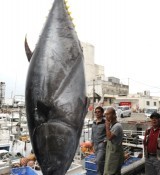
April 25, 2014 Ryukyu Shimpo
In the middle of the fishing season, Asumaru ship captain Masanori Isagawa caught a giant bluefin tuna weighing 327 kilograms at Tomari Port in Naha on April 25. Isagawa said with a smile, “After seeing the tuna caught by longline fishing, I was so happy.”
The fish will be sent to the Tsukiji Fish Market in Tokyo for auction.
(English translation by T&CT)
Go to Japanese
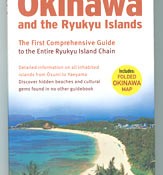
April 25, 2014 Ryukyu Shimpo
The Singapore-based Tuttle Publishing Company published an English tourist guidebook on Okinawa Okinawa and the Ryukyu Islands on April 24. The book targets foreign tourists visiting Japan and Okinawa. The company plans to publish 16 countries and regions around the world, including the United States, Canada, the United Kingdom, and the United Arab Emirates.
An Okinawa resident American Robert Walker who has been living in Okinawa for about 15 years, wrote the book. Teaching at the University of Maryland University College Kadena Air Base, Walker visited 150 islands, including the mainland of Okinawa, the Yaeyam islands, Yoron Island, and the Satsunan Islands.
The publisher printed the book on A5 coloured paper with 287 pages.
Written from the viewpoint of foreigners, the book provides information on each island’s transport, hotels and restaurants, history and culture, sightseeing areas for families and nature walk areas.
It explains the history and significance of Okinawan turtleback tombs. It also tells readers how to make Goya chanpuru.
The appendix of the book is a foldable map written in English.
The book is selling at Junkudo Shoten Naha Branch, Ryubo Book Center and Miyawaki Shoten Kokusai Street Branch. The price is 2,500 yen, including tax.
(English translation by T&CT)
Go to English
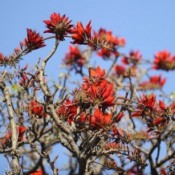
April 12, 2014 Ryukyu Shimpo
On April 11, the Okinawa Meteorological Observatory announced Deigo or tiger’s claws are in bloom in Naha. They have arrived 10 days later than last year. It was a summery day with a maximum temperature reaching 25.5 degrees Celsius. Last year, deigo bloomed on March 27. Pedestrians enjoying the bright-red flowers of deigo at an observation point in Yogi Park in Naha, felt the beginning of summer. Deigo were observed in bloom on Ishigaki Island on March 16. According to the Okinawa Meteorological Observatory, deigo have not bloomed since 2009 in Minami Daito. Miyako islanders are still awaiting deigo’s bloom, which is a bit delayed from last year.
(English translation by T&CT, Hitomi Shinzato)
Go to Japanese

April 25, 2014 Ryukyu Shimpo
Hotels and travel agencies expect a bumper Golden Week this year, with an increase in domestic and international tourists.
According to JTB Okinawa, domestic customers’ bookings for hotels in Okinawa were up about 20 percent from the same period last year. There also remains high demand for Okinawan tourism from Asia during Golden Week. Bookings for the resort hotels in Onna, Nago, and Motobu are high. According to the Kariyushi Group, the booking for the Okinawa Kariyushi Beach Resort Ocean Spa in Onna had a 43 percent increase from the previous year. The tourists’ reservations for the Okinawa Kariyushi Urban Resort Naha have also seen a 20 percent increase in the last half the golden week. “The domestic visitors’ travel destinations shifted to domestic from abroad due to the weak yen,” said a spokesperson of JTB.
The Naha City-based Okinawa Tourist Service said there has been a slight increase in group travel from Okinawa to the mainland such as Kansai and Tokyo area. Traveling abroad was almost on par with the previous year. Okinawans appear undettered by the consumption tax hike when it comes to taking advantage of direct flights from Naha to nearby destinations such as Taiwan, South Korea and Hong Kong. These places are gaining in popularity among Okinawans. According to the Naha office of H.I.S, most tourists have made their bookings for hotels and tour travel during the second half of Golden Week from May 3 – 6. This relatively shorter than last year because golden week public holidays are not consecutive this year.
(English translation by T&CT)
Go to Japanese










 Webcam(Kokusai Street)
Webcam(Kokusai Street)


